14 Of The Best Types Of Bread For French Toast
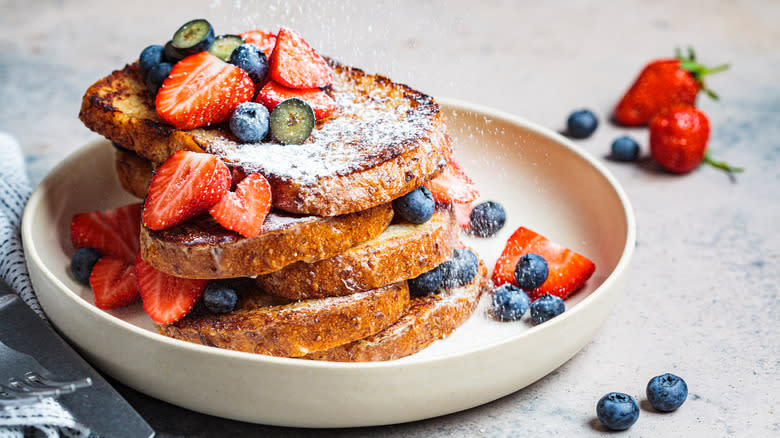
Pain perdu, or French toast, is a dish best defined by the translation of its name. Translated to "lost bread," this breakfast delicacy revives stale bread otherwise destined to be lost to the garbage bin by bathing it in a luxurious egg custard before pan-searing it in butter. The result is a fluffy, delicious morsel that will brighten the day of even the grumpiest morning person.
The key to making the perfect French toast lies within the crust of that lost bread. French toast requires a hardy, delicious bread stale enough to be primed to absorb enough liquid into its nooks and crannies to become saturated without dissolving into a pile of goo. It should also be thick enough to be satiating but not so dense that it will take forever to sop up that velvety egg custard.
Whether you make a classic variation, stuff it, bake it into a casserole, or create a savory iteration using various meats and vegetables, selecting the best bread for your French toast is necessary. As a chef who owned a bed and breakfast and restaurant for almost two decades, I could practically make French toast in my sleep. I am here to share the secrets to my French toast success and why each type of bread is ideally suited to creating your perfect pain perdu. Read on to discover what is hiding within the custard in my frying pan.
Read more: 14 Liquids To Add To Scrambled Eggs (And What They Do)
Brioche

If I had to select just one bread for French toast, I would choose brioche. It is hands down the best bread for this purpose for several reasons owing to its basic structure. Brioche is a bread of French origin made in one form or another since the Middle Ages. The key to its distinct flavor, texture, and color is that it is made with an enriched dough.
Enriched doughs, or Viennoiseries, typically contain eggs, milk, butter, or sugar. In the case of brioche, it is made using sugar, eggs, and copious quantities of butter. This yields a bread that is almost more like a cake than bread. It is sweet, supple, and exceedingly rich. And because it contains a significant amount of sugar, it tends to brown faster than plain white bread, making it the ideal choice for French toast.
When using it for French toast, be careful not to over-soak brioche in your egg custard, or it can become overly soggy, even if the bread is stale. The inherent moisture in brioche makes it slow to dry out, so it is usually less desiccated than stale white bread even after a week.
If you can obtain it, I love using brioche laced with cinnamon or chocolate for making French toast. It yields an even more special sweet treat. Otherwise, regular brioche can easily be used for any French toast recipe, sweet or savory.
Challah
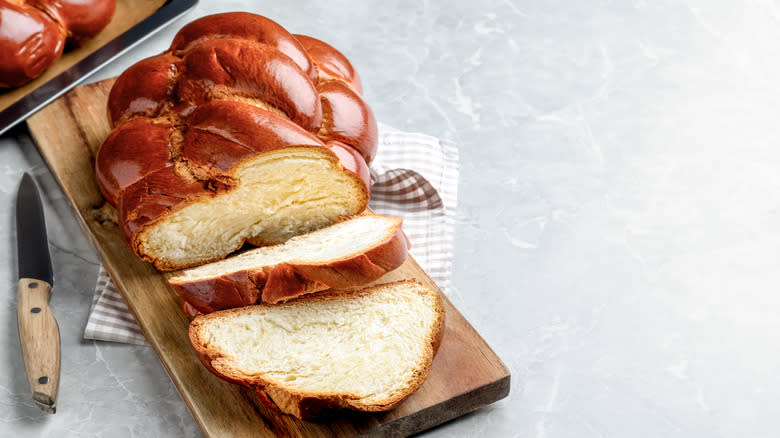
Challah is another bread produced from enriched dough that shares characteristics similar to brioche, ranking it a second favorite for making French toast. This traditional Jewish bread is characterized by its distinctive braided patterns and shapes. It contains eggs, oil, and, on occasion, sugar. Though it first appeared in writing among Ashkenazi Jews in the 15th century, a variation of this bread, known as berches, was made in the Middle Ages in Germany, Austria, and Bohemia.
Though it can come in round loaves, those best for French toast are the classic, elongated ones with a shiny, dark brown crust. It is best to obtain a whole loaf and cut it into ?-inch slices. I recommend purchasing a plain one without sesame or poppy seeds scattered over the top of the crust. The seeds can be bitter and fall off into the egg custard, leaving little pockets that cook unevenly. Like brioche, challah tends to retain its moisture for quite a while, which makes it slow to stale and quick to absorb the egg custard, so take precautions and avoid soaking it for too long.
My favorite way to use challah is in a stuffed French toast recipe. Sandwich two pieces of challah with thin slices of fresh mozzarella and lemon curd before soaking briefly in the egg custard and pan-searing both sides. Finish this in the oven for a few minutes to ensure the cheese has melted and the custard has cooked through before serving it topped with melted blueberry preserves.
Pain De Mie Or Pullman Loaf

Pain de Mie, also known as a Pullman Loaf, is a classic French sandwich bread characterized by its distinctive symmetrically square shape, supple texture, and more uniform crumb, all features that make it ideal for making French toast. This unique shape and texture are conferred by the pan in which this loaf is baked. The Pullman Loaf pan originated in 18th-century Europe but was not popularized in the United States until the early 2000s. The pan gets its name from the Pullman railway system, which began using it to obtain compact, space-saving loaves that were methodically stacked in the narrow dining cars.
What makes this pan special is how the lid constricts the natural expansion process of the dough. Rather than being allowed to spread naturally, the bread is forced to rise and fill every nook and cranny within its confines. This intense concentration encourages steam production within the pan, resulting in a spongy loaf that will remain moist longer. The typical dough used to make a Pain de Mie is enriched, though you can use the Pullman Loaf pan to make practically any bread recipe.
While you can buy a commercially produced Pullman loaf, it is often not uniformly square, even if it has the correct consistency that makes it so attractive for making French toast. For this reason, many prefer investing in Pullman loaf pans and baking a homemade Pain de Mie. Not only does this ensure the loaf will be perfectly square, but you can also control the quality of ingredients.
Sourdough
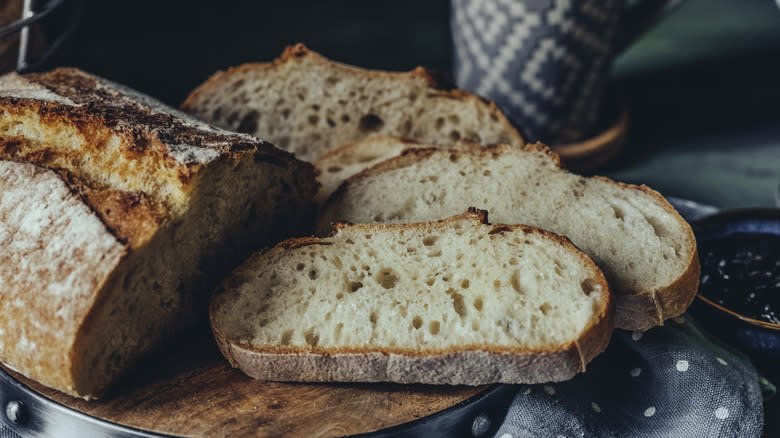
Sourdough is a bread-making technique dating back thousands of years. Indeed, the ancient Egyptians purportedly used the spoils of myriad ingredients to start the fermentation process responsible for baking bread. These starters are generally created using flour and a liquid exposed to bacteria, like lactobacilli, within the grain and the surrounding air. As these microorganisms begin feeding on this starter, they put off carbon dioxide-emitting byproducts that cause bread to rise. They also confer a funky flavor that eventually gives sourdough its distinct tangy taste.
The resulting bread has notes of acidity, a crisp crust, and a chewy interior dotted with small pockets that can readily absorb liquids. Its distinct flavor and texture make sourdough perfect for French toast. It can be left for quite a while to soak in the egg custard without disintegrating while it thoroughly mops up every bit of it. Once cooked, the resulting French toast is equally sweet and sour, lending a sophisticated complexity.
Sourdough is also well-suited to savory French toast recipes, like baked casseroles with meat and eggs. These can be left to soak in the egg custard overnight, making the bread fluffy and soft while retaining its inherent funkiness. Add sautéed mushrooms, grated parmesan cheese, and cured meat, like prosciutto, to the French toast for a pop of umami flavor. Serve with a light Italian salsa cruda or pesto for a tangy, refreshing garnish.
Croissant
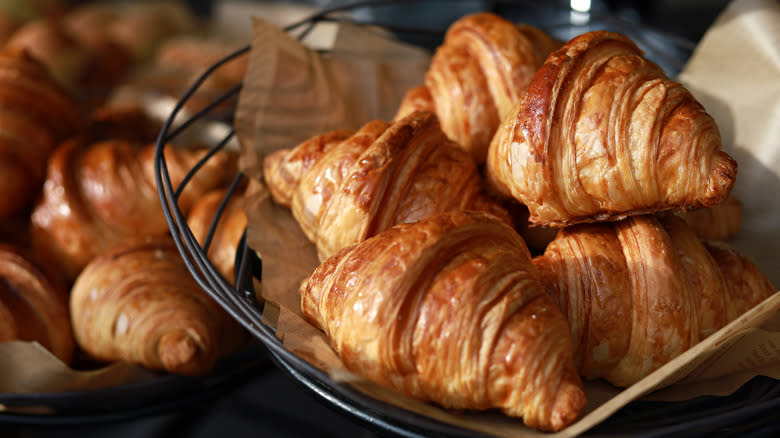
Though the iconic croissant is most often associated with France, its origins hail from Austria, and a yeasted pastry is known as a kipferl. The kipferl was not introduced to Paris until the late 1830s, after which its modern iteration evolved. The characteristic change was the introduction of the lamination technique. In this technique, a plain or enriched yeast dough is folded, and cold butter cubes are rolled into it repeatedly, forming hundreds of impossibly thin layers of flaky, voluptuous dough.
The key to the perfect croissant is maintaining the cold butter temperature, which, when baked, will separate into butterfat, milk solids, and water. When the water evaporates, it leaves pockets of air behind, creating a striated structure similar to a honeycomb. The subsequent butterfat fries the dough, developing a delicate yet crispy pastry with a caramelized, shiny crust. This honeycomb structure is ideal for an egg custard to permeate, fusing with the hundreds of layers of pastry and creating a luxurious French toast worthy of royalty.
When using a croissant for French toast, you can cut it in half or into pieces for a casserole similar to a bread pudding. My favorite is to incorporate Grand Marnier or Cointreau into the egg custard for a boozy delight perfectly accompanied by an orange marmalade or raspberry preserves. For an even more indulgent French toast, use one of the many cousins of the croissant, like the pain au chocolat or croissant aux amandes.
Cinnamon Raisin Bread
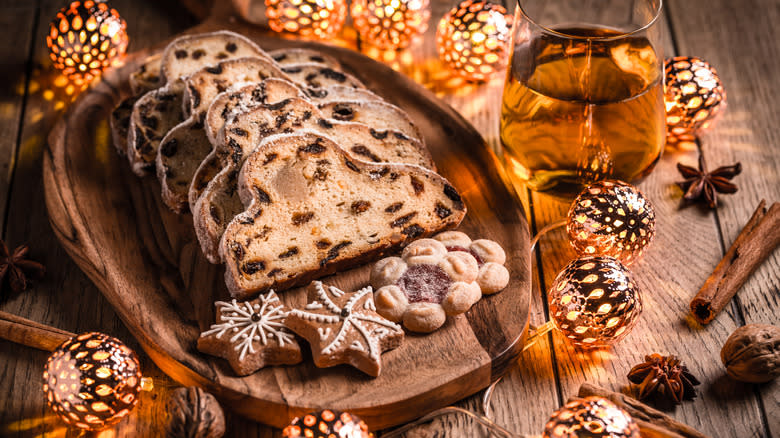
Perhaps it shouldn't surprise anyone that a cinnamon raisin bread would be a terrific vessel for making a delectable French toast. The combination of the spicy cinnamon with the rustic savoriness of a chewy bread dotted with the slightly tart sweetness of raisins conjures memories of a classic noodle kugel that was a staple in my Eastern European Ashkenazic Jewish household growing up. Though a kugel mixes noodles, eggs, raisins, cinnamon, and a cheese blend made with either cottage or ricotta cheeses, the notion of an egg custard-soaked cinnamon raisin bread is similar enough to elicit intense nostalgia.
The key is getting a good quality cinnamon raisin bread or making your own. It should be rife with cinnamon and have enough plump raisins to be distinguishable. I like brands that have swirled veins of cinnamon throughout the loaf. When soaking the bread in the egg custard, the raisins will begin to rehydrate. Once heated, they will burst with a sticky, syrupy juiciness that punctuates the fluffy bread and zesty cinnamon.
Cinnamon raisin bread is also distinctly well-suited for stuffed French toast. A favorite is a twist on Elvis Presley's preferred sandwich, peanut butter and banana with bacon. In this case, spread crunchy peanut butter and layer sliced bananas between two slices of the cinnamon raisin bread. Soak this in the egg custard, sear it in butter, and finish it in the oven for a few minutes. Serve this with bacon for a breakfast that is fit for the king of rock and roll.
Hawaiian Sweet Bread
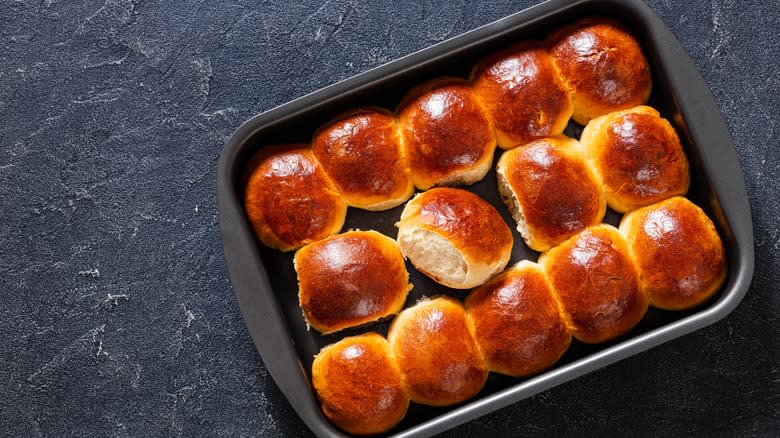
Traditional Hawaiian sweet bread is a hybrid between a brioche and something more akin to a cake. Its texture is pillowy while its flavor is sweet but not cloying, making it perfectly ono or delicious when turned into French toast. It is generally made from a combination of bread and potato flour enriched with milk, eggs, butter, sugar, and pineapple juice, which lends sweetness and acidity to the dough. Though you can make your own, commercially produced King's Hawaiian bread or rolls are ideal for spreading the aloha spirit to your `Ohana or extended family.
When using this kind of bread for French toast, you will want to use similar considerations to brioche. This bread is moist and stays supple for quite a long time, so do not over-soak it in your egg custard. You will also want to be cautious when cooking this French toast so it doesn't brown too rapidly.
This bread is more suitable for a sweet versus savory French toast recipe. While the slices are convenient for a classic recipe, the rolls are the perfect size for making a French toast casserole. Whip up a tropical variation on the theme. Season your egg custard with Li Hing Mui powder and whisk in coconut milk and a tablespoon of rum. Combine the rolls with canned, crushed pineapple, and chopped-up toasted macadamia nuts. Soak these in the egg custard before topping with shredded coconut and baking.
French Bread
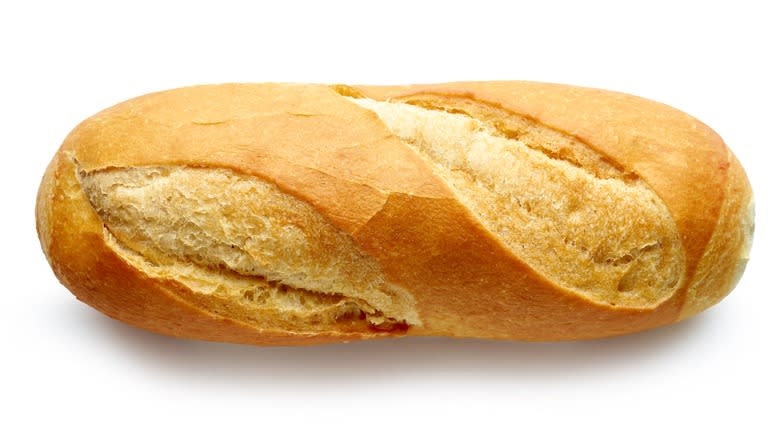
When referring to "French bread," I am talking about the generic loaf you often see labeled as such at most American grocery stores. This bread is not representative of the vast catalog of different kinds of bread for which the French are known, but it is a good quality bread for use in a French toast recipe. It is typically lengthier and broader than a traditional baguette, with a less dense crust. It has a somewhat chewy texture and spongy interior well-suited for soaking up egg custard.
Because this bread is seldom enriched with milk, eggs, butter, or copious quantities of sugar, it will stale more quickly, giving it plenty of opportunity to absorb your egg custard without dissolving. I recommend purchasing a whole loaf if you can find one and slicing it yourself into pieces roughly ? of an inch thick.
This type of bread can be used for a sweet or savory French toast recipe and is versatile enough for a classic or casserole variation. While there isn't anything particularly exotic about French bread, it is affordable and widely available, making it a worthy option for a quick yet special breakfast on a Sunday morning.
Milk Bread
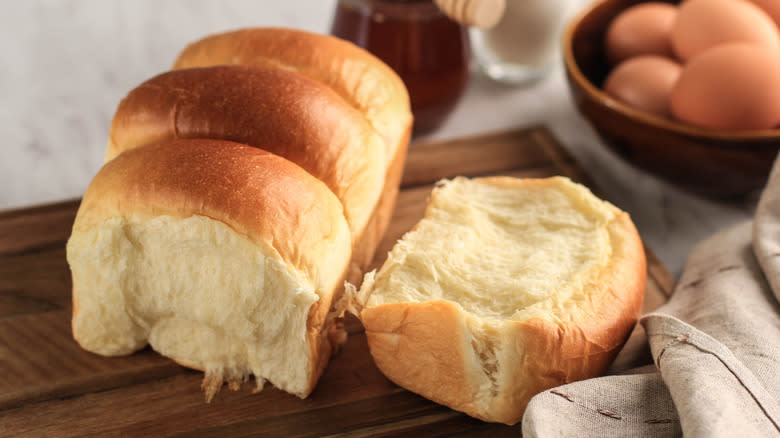
While the origins of Japanese milk bread, or shokupan, remain somewhat mysterious, this type of loaf, which has a virtually non-existent crust, sweet flavor, and a spongy interior that pulls apart in string-like cottony strands, is having a moment thanks to social media. Though it resembles typical uninspiring white loaves of commercially produced bread in the U.S., its qualities make it unique.
Milk bread is an enriched bread with a long shelf-life thanks to high levels of fat in the dough. While recipes are as varied as households, they all have the same bouncy texture and rich flavor. A regular preparation method that gives this bread its moniker is fashioned from a combination of flour and milk that is gently heated, known as tangzhong.
This type of bread comes in many shapes, including rolls and Pullman-style loaves called kaku-shoku. Any of these would make for a delectable French toast. This bread does not stale quickly, like brioche or challah, so do not over-soak it in the egg custard. Its high-fat content will cause this bread to brown rapidly, so it may be better to start your French toast in the pan and finish it in the oven to cook it thoroughly without burning it.
Italian Bread
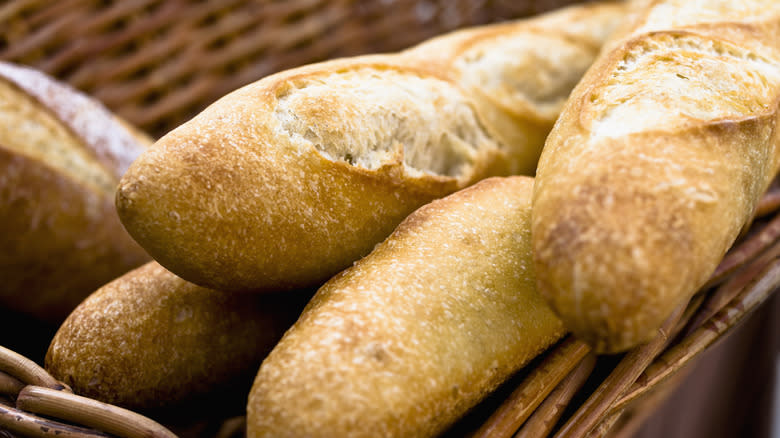
Like French bread, Italian bread is not a monolith. That said, when visiting virtually any grocery store in the U.S., you will come across a rustic loaf labeled "Italian," which will be well-suited for making any French toast recipe. This bread differs from the generic French loaf in that it tends to be slightly shorter and flatter with a similar crust that is firm but not hard and an interior texture that is springy with a tight crumb.
Again, like the generic French loaf, you often can find Italian bread for sale whole rather than sliced, which is preferred. You can then slice your bread into ?-inch thick segments, ideal for your everyday French toast recipe. When slightly stale, this bread is sturdy enough to soak for quite a while in your egg custard, absorbing a lot of the liquid and creating a fluffy result.
It can also be used in a French toast casserole you plan to assemble the night before a party. Because its flavor is not overly sugary, you can easily use Italian bread for a sweet or savory French toast recipe. This is an affordable and widely available type of bread that is versatile.
Focaccia
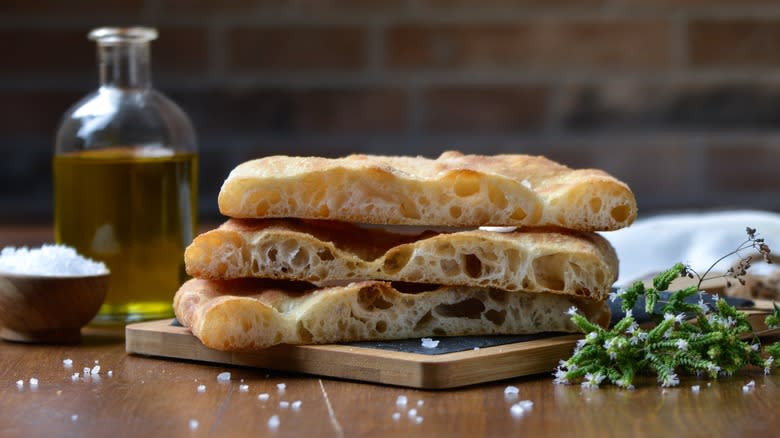
Speaking of Italian bread, among the hundreds of different varieties, one of the most popular and widely available is focaccia. Focaccia is a type of flatbread made similarly to pizza dough but has slightly more yeast, making it rise more and yield a puffier result. The crust of the dough is typically dotted with holes, preserving moisture and creating pockets for myriad toppings to be added.
Though focaccia is often made using savory ingredients and copious quantities of olive oil brushed generously atop the bread, it can also be made using sweet ingredients, like dried fruit and nuts. You can use focaccia for sweet and savory French toast recipes, depending on which you obtain or bake yourself.
When using focaccia, you will want the bread stale for a day or two and then cut it into wedges. These can be soaked in your egg custard before pan-frying in butter. I prefer using focaccia for savory recipes, particularly French toast casseroles, where I can play with ingredients. This kind of dish is a superb way of using up leftover vegetables and repurposing them. You can also toss in chunks of leftover meat, like ham or turkey, for a little French toast for dinner action. Serve it with a green salad in a light vinaigrette for a satiating meal that comes together in a flash.
Gluten-Free Bread
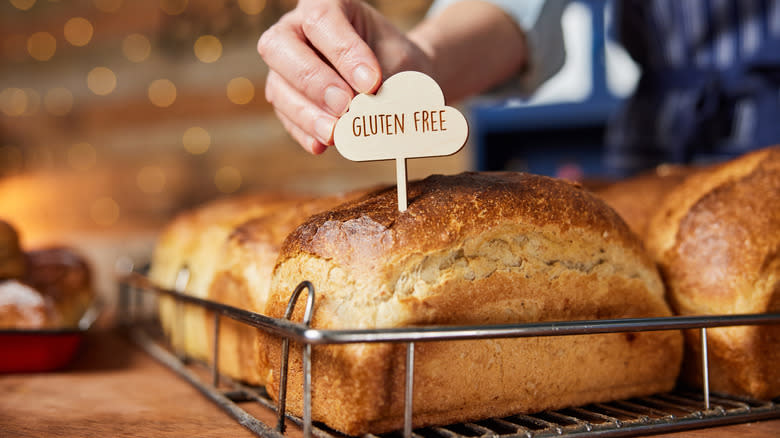
I would be remiss in not discussing using gluten-free bread to make French toast. One of the things that our bed and breakfast was known for was accommodating dietary restrictions of all kinds. The most common one we got was a gluten intolerance, allergy, or celiac disease. A treat for these individuals was providing them with a breakfast they couldn't typically eat, like French toast. I would always make it for breakfast at least once during their stay, but it did take additional preparation and know-how.
First, not all gluten-free breads are made alike. While you want to use stale bread that can absorb the egg custard, some gluten-free breads are overly crumbly and will not hold together once they dry out. I often prefer the varieties sold in the frozen foods section. They remain fresh longer and tend to have a better texture. That said, if you have a brand you enjoy and have on hand, use it.
For those unaccustomed to cooking for gluten-free individuals, you always want to be cautious about cross-contamination. Never use the same egg custard, spatula, or pan for your gluten-free and regular bread French toast. I recommend making a French toast casserole using gluten-free bread that you soak overnight. Combine it with plenty of moist ingredients, like berries, to help keep the finished product supple, and serve with lots of real maple syrup. All your guests, regardless of whether or not they need to eat gluten-free, will enjoy this.
Donuts Or Cinnamon Rolls
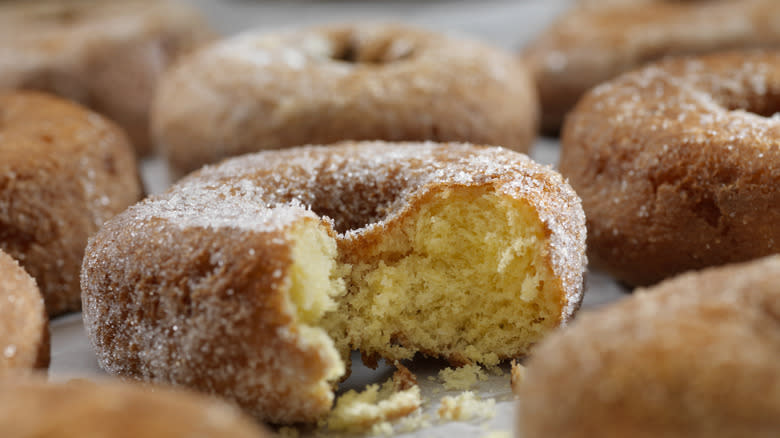
While the likelihood of having leftover donuts or cinnamon rolls is slim, don't discard them if you find yourself in this position. They make for a ridiculously sinful French toast that will have your family asking you to buy donuts or cinnamon rolls all the time just so that they can let them go stale. For individual servings of French toast, slice the donut or cinnamon roll in half before soaking it in your egg custard. If you plan to make a French toast casserole, cut the donuts or cinnamon rolls in quarters before placing these pieces in a baking dish and adding the egg custard.
The porous nature of these types of dough will sop up the egg custard beautifully, yielding a luxurious, creamy French toast that is so sweet you may not even need to add syrup. Use leftover stale fruit or chocolate-filled donuts for your French toast for an even more indulgent treat. For these, you will want to leave them whole. Once the finished dish comes out of the oven, your guests will squeal with glee when they cut into the French toast, and melted jam or chocolate comes oozing out.
Whole Wheat Bread
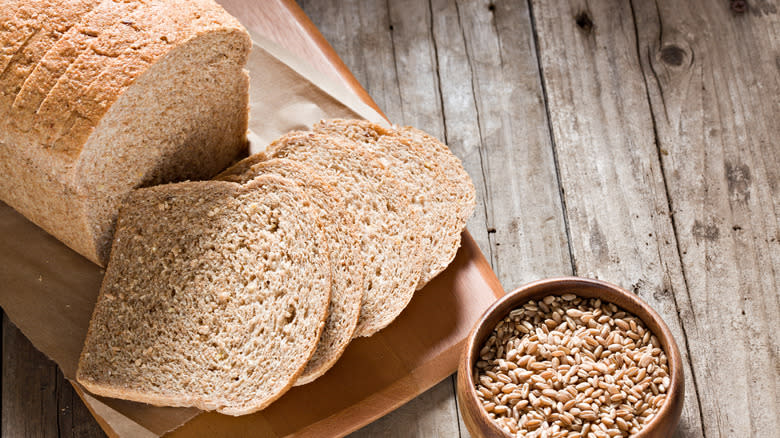
According to the Cleveland Clinic, bread labeled "100% whole-grain" or "100% whole wheat" is loaded with fiber and nutrients that are retained by the inclusion of the bran, germ, and endosperm of the wheat kernel. This can make them rather intense in flavor and dense in texture, but there is no reason you couldn't substitute them for white bread in your favorite French toast recipe.
The key is to use whole wheat bread without seeds, nuts, or oats coating the exterior crust. These toppings can fall into the egg custard, causing inconsistent pockets that won't cook evenly. Though you can use whole wheat bread for a sweet or savory French toast, I prefer it for a savory variation.
A favorite recipe is a stuffed French toast that sandwiches wheat bread with pesto, thin slices of fresh mozzarella, and a slice of mortadella or ham. Once soaked in egg custard, pan-fry the French toast lightly on each side before finishing it in the oven to allow the cheese to melt completely. Serve this with a dollop of gremolata or a romesco sauce for the ultimate fancy, grown-up French toast.
Read the original article on Daily Meal.
